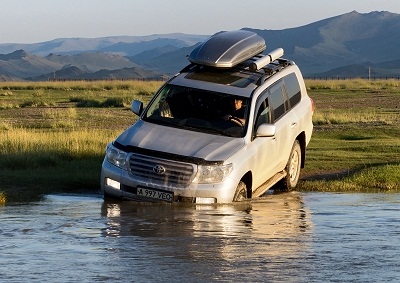
CAPE TOWN - Water crossings can be exhilarating and challenging behind the wheel of a 4x4 but to the untrained can prove to be a costly experience.
From vehicle preparation to driving techniques, the African Off-Road Academy's Andre Botha shares advice on tackling water crossings.
Botha writes: “A 4x4 is not an amphibious vehicle, in fact few are even waterproof. The actual depth that you can cross depends on your vehicle. For example, a stock Chevrolet Blazer may be submerged at a depth that doesn't even wet the door sills of a Toyota Hilux.”
'NOT TO BE TAKEN LIGHTLY'
“A water crossing is something that should not be taken too lightly as it has the potential to do expensive engine and drive-train damage. However, with the right vehicle preparation and post crossing maintenance, you can enjoy some of the most challenging 4WDriving around.”
As a rule, if water levels are above the top of your wheels it’s probably too deep. A water crossing should not be attempted by inexperienced or ill-prepared drivers.
WALK THE ROUTE
If you’re entering an area where water crossings are likely make sure your vehicle is prepared with the use of differential breathers, air intake and engine bay protection.
Botha writes: “The first thing to do before any unfamiliar water crossing is to walk it. If you cannot walk it you cannot cross it. If the water is flowing too quickly to safely walk the crossing, then it cannot be driven across. Remember, vehicles actually float until water seeps into them.
Words by:
Andre Botha, member of the African Off-Road Academy, courtesy of Arrive Alive.
“When you walk the crossing you are actually starting your vehicle preparation. You are giving the axles, diffs and gearbox time to cool down while you find out exactly how deep the water is.
“Prior to a water crossing, it is a good idea to place your recovery gear on top of other luggage. The last thing you want to be doing is scrabbling under your cooler-box, tents and baggage to find recovery gear when you're thighs-deep in a river.”
DRIVING TECHNIQUE
Before you enter the water, remember to take off your seat belt and wind down your window.
“Using low range second gear at 1500-2000 rpm (for most vehicles) creates just the right bow wave. Its important to get the speed just right as too fast will send water everywhere while too slow may flood the engine bay. Hopefully you follow your markers and get to the other side with no problems.
“If you do hit problems avoid using the clutch as this may allow water to get between the friction plate and the flywheel, resulting in limited drive. If the wheels start to slip, it’s important not to over-rev the engine but back-off the accelerator and hope the wheels regain traction. Excessive wheel-spin will not help.
“If the engine stalls, put the vehicle in neutral without using the clutch and attempt to restart. If luck is on your side the engine will fire up. Now is not a good time to wish you had already disconnected the fan belt, as your engine bay will be flooded. It’s normally best to use 1st gear low range and with a minimum of clutch usage, try and extricate yourself from this predicament.”
VEHICLE MAINTENANCE
Once you have successfully crossed, vehicle maintenance is critical to avoid costly repairs. Botha says any crossing at axle depth or deeper necessitates “a checking of the diff oil for water contamination.
“Having an extended diff breather is not a guarantee of waterproofing and any crossing above your axles without extended cliff breathers should mean a mandatory inspection.”
“Checking your diffs for water contamination is very easy. Since water is heavier than oil, it will collect at the lowest point in the diff, right where the drain plug is located. After allowing time for your vehicle to cool, just loosen the drain bolt and run a small amount (+-20ml) of the diff oil into a glass. If you're unlucky enough to have water present, the diff oil should be drained. It is best to flush the diff several times to ensure all traces of water are removed. Milky coloured oil also indicates water is present and should also be changed.”
“It’s not only diffs than can have water contamination, but also your gearbox, transfer case and engine oil. However, it is usually only when a vehicle is stationary in deep water that these components are contaminated.”
WATER CROSSING SUMMARY
Vehicle preparation
• Walk the crossing to check its depth
• Don't cross fast-flowing water
• Place markers at hidden obstacles
• Place a tarp across the front of the vehicle
• Disconnect the fan belt if a viscous coupling fan is not fitted
• Spray water repellent on distributor and ignition wire
• Pack recovery gear on top, ready for use
Driving technique
• Take off seat belt and wind down window
• Use low range 2nd gear (in most situations)
• Drive at a steady speed to create a bow wave
• Avoid using the clutch
• Do not over-rev engine if you lose traction
• If the engine stalls, shift into neutral without using clutch to restart. Pull away in 1st gear low-range.
Post water-crossing maintenance
• Check diffs etc for water if depth above axles
• Check winches if fitted.
Click here to view the full article.




 Publications
Publications
 Partners
Partners














